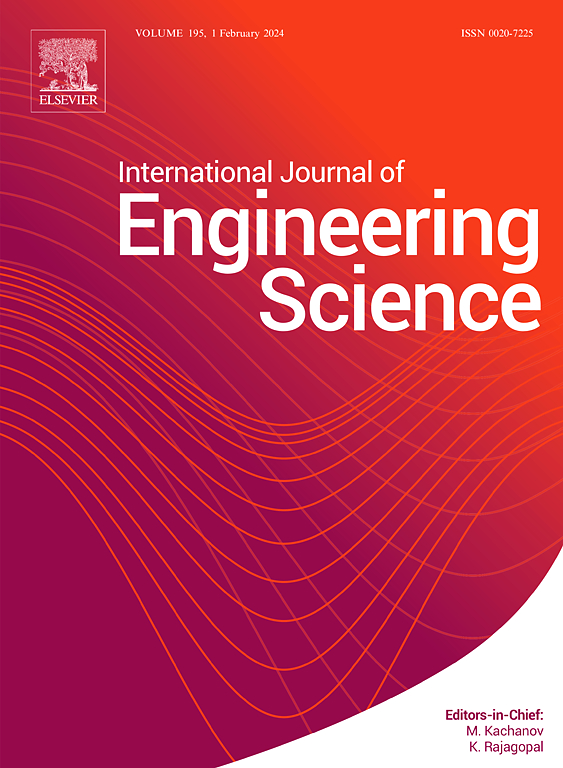Elastic waves in graphene origami-enabled auxetic metamaterial thickness-deformable doubly-curved shells
IF 5.7
1区 工程技术
Q1 ENGINEERING, MULTIDISCIPLINARY
International Journal of Engineering Science
Pub Date : 2025-03-23
DOI:10.1016/j.ijengsci.2025.104249
引用次数: 0
Abstract
This study, for the first time, investigates the bulk waves in mechanical metamaterial thickness- and shear-deformable doubly-curved shells; it considers spherical, elliptical, hyperbolic, and cylindrical shell structures. A third-order shear deformable model, involving thickness deformation, is employed to capture in-surface and out-of-surface, rotational, and stretching motions within a curvilinear coordinate system. Equations of motion are obtained via Hamilton’s principle, resulting in a set of coupled partial differential equations. A genetic programming-based micromechanics method for mechanical properties has been developed in the literature recently; this paper uses it as simulation inputs. A harmonic approach is used to solve these equations and to obtain the circular frequency. For the spherical, elliptical, hyperbolic, and cylindrical shells, influences of the curvatures on the wave frequency are highlighted. In the Appendix, a comparative analysis for a simplified case (excluding metamaterial effects, and multilayer configurations) demonstrates very good agreement with prior studies.
石墨烯折纸辅助超材料厚度可变形双弯曲壳中的弹性波
本文首次研究了机械超材料厚度和剪切可变形双弯曲壳中的体波;它考虑了球形、椭圆形、双曲和圆柱壳结构。一个三阶剪切变形模型,包括厚度变形,被用来捕捉曲面内和曲面外,旋转和拉伸运动在一个曲线坐标系。利用哈密顿原理得到运动方程,得到一组耦合的偏微分方程。近年来,基于遗传规划的力学性能微力学方法得到了发展。本文将其作为仿真输入。采用谐波方法求解这些方程并得到圆频率。对于球壳、椭圆壳、双曲壳和圆柱壳,强调了曲率对波频率的影响。在附录中,对一个简化情况(不包括超材料效应和多层结构)进行了比较分析,结果与先前的研究结果非常吻合。
本文章由计算机程序翻译,如有差异,请以英文原文为准。
求助全文
约1分钟内获得全文
求助全文
来源期刊

International Journal of Engineering Science
工程技术-工程:综合
CiteScore
11.80
自引率
16.70%
发文量
86
审稿时长
45 days
期刊介绍:
The International Journal of Engineering Science is not limited to a specific aspect of science and engineering but is instead devoted to a wide range of subfields in the engineering sciences. While it encourages a broad spectrum of contribution in the engineering sciences, its core interest lies in issues concerning material modeling and response. Articles of interdisciplinary nature are particularly welcome.
The primary goal of the new editors is to maintain high quality of publications. There will be a commitment to expediting the time taken for the publication of the papers. The articles that are sent for reviews will have names of the authors deleted with a view towards enhancing the objectivity and fairness of the review process.
Articles that are devoted to the purely mathematical aspects without a discussion of the physical implications of the results or the consideration of specific examples are discouraged. Articles concerning material science should not be limited merely to a description and recording of observations but should contain theoretical or quantitative discussion of the results.
 求助内容:
求助内容: 应助结果提醒方式:
应助结果提醒方式:


